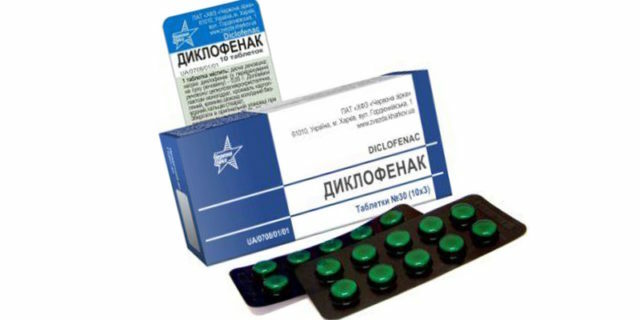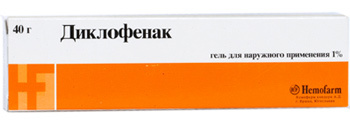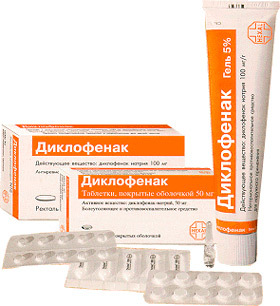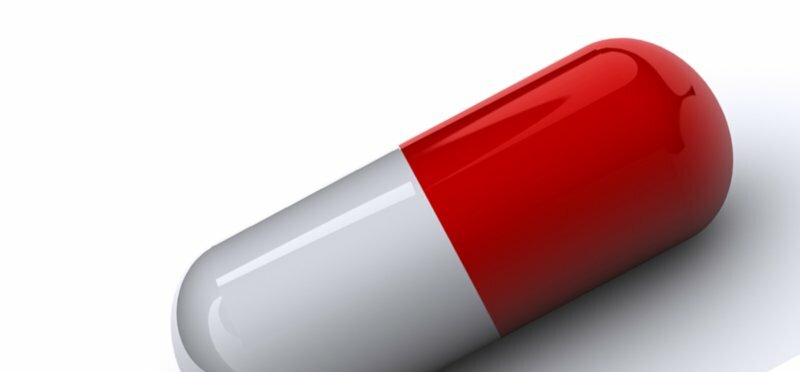
Page Contents
- 1 Diclofenac: Description, How It Works
- 2 Forms of Release
- 3 When Will Diclofenac Help?
- 4 Diclofenac: adverse reactions
- 5 Analogues, price
- 6 Feedback on the application of
Diclofenac is one of the most popular and often prescribed drugs used to combat pain and inflammation. Instructions for use Diclofenac reveals all the features of the use of the drug in the treatment of various pathologies. Diclofenac is produced in various dosage forms, which significantly expands its use in various branches of medicine.
Diclofenac: Description, Principle of Action
Diclofenac is a drug from the group of non-steroidal anti-inflammatory drugs( NSAIDs), a derivative of phenylacetic acid. The active substance - sodium diclofenac, has a powerful anti-inflammatory, analgesic and low antipyretic effect.
Application of the drug for rheumatic diseases allows you to quickly stop the inflammatory process, remove strong pain, reduce puffiness, morning stiffness and restore the function of the joints. In the postoperative period, with trauma or inflammatory processes of non-infectious etiology, Diclofenac relieves pain and eliminates edema.
This is due to the fact that the active substance of the drug interferes with the process of chemical regulation of inflammation. The mechanism of action of Diclofenac is based on blocking the synthesis of biologically active substances that trigger the inflammatory process.
By reducing the amount of prostaglandins, pain, heat, and swelling disappear. Compared with other NSAIDs, this drug works much more effectively, which makes it indispensable in the treatment of many neurological and inflammatory-degenerative pathologies accompanied by an intense pain syndrome( neuralgia, lumbago, isalgia, radiculitis, osteochondrosis).
After taking the active substance the drug is quickly and completely absorbed into the digestive tract, and its concentration in the blood reaches a maximum after 1 hour and retains therapeutic effect for quite a long time. The active substance penetrates well into all body fluids, is metabolized in the liver, excreted mainly by the kidneys, a small part comes out as metabolites with bile.
Forms of release
 Photo: Diclofenac gel from joint pain
Photo: Diclofenac gel from joint pain For convenience of use, diclofenac is available in a wide variety of dosage forms:
- tablets in an enteric coating( 25,50 mg);
- capsules prolonged action( 100 mg);
- rectal suppositories( 50 and 100 mg);
- ointment Diclofenac( 1% and 2%);
- gel Diclofenac( 1% and 5%);
- Diclofenac injections in ampoules for intravenous administration;
- eye drops( 0.1%).
Tablets of Diclofenac, as well as injections, are very helpful in rheumatic joints and diseases accompanied by severe pain syndrome. Local funds in the form of a gel and ointment are used for external treatment of inflammatory foci in order to eliminate puffiness and painful sensations. Eye drops Diclofenac is prescribed for the treatment of post-traumatic conditions.
When will Diclofenac help?

Diclofenac is widely used in various fields of medicine - neurology, traumatology, ophthalmology, rheumatology. Nevertheless, the main purpose of the drug is the therapy of rheumatic diseases. Diclofenac is administered under the following conditions:
- chronic inflammatory-degenerative joint damage in rheumatoid arthritis, rheumatism, spine diseases( osteochondrosis, spondylitis), osteoarthrosis;
- gouty, juvenile or psoriatic arthritis, tendovaginitis, bursitis;
- in order to eliminate the pain syndrome accompanied by inflammation, the drug is prescribed for radiculitis, myalgia, neuralgia, lumbago, sciatica.
- tableted forms are used for the treatment of dental and headache( migraine);
- local forms( ointment, gel) help to alleviate the condition and relieve pain syndrome in injuries to muscles, ligaments( dislocations, bruises, sprains);
- as part of complex therapy Diclofenac is used in the treatment of diseases of the ENT organs - tonsillitis, otitis or pharyngitis.
In addition, this drug from the NSAID group helps alleviate the condition in painful menstrual or inflammatory processes affecting the female organs( adnexitis).In the ophthalmology of drops, Diclofenac is used to relieve the pain syndrome in the postoperative period or to stop the inflammatory process with non-infectious conjunctivitis or trauma to the eyeball.
Diclofenac injections are given intramuscularly, and with the development of generalized inflammatory reactions, injections are injected directly into the patient's joint.
Contraindications

Diclofenac in any form is not prescribed if there is a suspicion of acute surgical pathology, accompanied by pain in the abdomen of unknown origin - in this case, the use of pain medications complicates the diagnosis and is permissible only with the permission of the doctor.
The drug should not be used during an exacerbation of gastritis and gastric ulcer. Also, you should refrain from treating Diclofenac with pregnant and lactating women, children under 6 years. These contraindications can be considered relative, because they require to postpone treatment for another time. But in addition to them there are absolute contraindications, which require complete discontinuation of the drug. These include:
- renal and hepatic insufficiency;
- heart failure;
- any hematopoiesis;
- hypersensitivity;
- inflammatory processes in the intestine;
- peptic ulcer of the stomach and duodenum;
- gastric bleeding;
- heart failure.
Treatment with Diclofenac

According to the instructions, tablets Diclofenac should be taken without chewing, squeezed with sufficient volume of liquid. Dosage regimen and duration of admission the physician selects individually taking into account the severity of the condition and possible contraindications. The standard dose of Diclofenac for adults is not more than 150 mg per day, divided into several doses. The course of treatment is usually short-term. After the necessary therapeutic effect has been achieved, the dosage is reduced to a minimum. Diclofenac dosage for children( over 6 years old) and adolescents is selected at the rate of 2 mg / kg body weight.
Diclofenac is administered in injections in courses. Only the doctor decides how many days can be given injections, given the characteristics of the disease, the severity of the symptoms, the general condition of the patient and the tolerability of the drug. Diclofenac is injected intramuscularly only into large arrays of muscle tissue - the upper-arm quadrant of the buttock or the front surface of the thigh. In diseases of the spine or small joints, the drug is injected every 12 hours for two days, then it must be replaced by taking the tablets. With pain syndrome, not associated with the joints - it is administered once, if necessary.
In cases of lesions of large joints, most often the knee, the drug is prescribed in the form of injections into the joint cavity. The number of injections depends on the severity of the inflammatory process. Usually the course of treatment lasts 5-7 days, the injection is put once a day. The procedure is necessarily performed in a day hospital, polyclinic or medical center, as it requires sterility of the room and instruments and high qualification of medical personnel.
In no event should Diclofenac injections be administered subcutaneously or intravenously - this leads to necrotic tissue changes. If the intra-articular injection is incorrectly formulated, the ligamentous apparatus of the knee joint may be damaged and necrotic lesions developed in it.
Diclofenac: Adverse Reactions
Like most non-steroidal anti-inflammatory drugs, diclofenac has quite a few side effects. The use of the drug can cause reactions from:
- digestive tract( nausea, vomiting, bleeding from the gastrointestinal tract, ulcerative lesions);
- of the nervous system( dizziness, headache, weakness, insomnia, irritability);
- respiratory system( bronchospasm, cough);
There are violations of the liver, hematopoietic system, kidneys, blood pressure jumps, allergic reactions.
With intramuscular application, there is often a sharp pain in the area of administration, possibly the formation of a hematoma, infiltration or abscess. There are possible changes in the laboratory indicators of urine and blood, so the treatment of diclofenac should be warned by the doctor giving direction to the analysis.
Intra-articular injections practically do not give systemic side effects, but require a good nurse qualification. Incorrect introduction can lead to the development of an inflammatory process in the knee joints, impaired mobility, hematomas. Even with proper performance, intra-articular injections are extremely painful.
Analogues, the price of

Diclofenac has quite a number of structural analogs to the active substance. So, pills and injections of Diclofenac can be replaced with such drugs as Voltaren, Diklogen, Diklak. Ointment forms with a similar therapeutic effect are the drugs Diklak lipogel, Diclofenac Acry. Eye drops can be replaced with such medications as Voltaren Ofta or Uniklofen.
Among other drugs with a similar mechanism of therapeutic action, there are such drugs as Ibuprofen, Indomethacin, Nyz, Nurofen, Fastum Gel, Meloxicam, Movalis.
The price of Diclofenac in the pharmacy network depends on the form of release of the drug and the wrapping up of pharmacists. In general, this is a fully budgetary tool available to a wide range of people. Here is the average cost of the drug:
- Tablets Diclofenac( 20pcs.) - from 20 rubles;
- Gel Diclofenac - from 110 rubles;
- Suppositories rectal - from 140 rubles;
- Diclofenac injections - from 80 rubles.
Feedback on the application of
Overall reviews confirm the effectiveness of the drug, but at the same time, it is said that its use often causes side reactions. Therefore, the treatment should begin only after consulting a doctor and identifying possible contraindications.
Review No. 1
I have long been suffering from such an unpleasant disease as gonarthrosis. Exacerbations occur regularly, 2-3 times a year, especially in the damp, spring-autumn period. At this time I suffer from excruciating pains in the joints.
During the next acute exacerbation rheumatologist prescribed Diclofenac. It is worth the drug is very inexpensive, the pharmacy is released freely. So, relief was felt already on the second day after the beginning of treatment. The course took only 5 days.
But the doctor warned that the repeated course can be performed no earlier than in six months, since Diclofenac is capable of provoking a stomach ulcer with frequent use.
Oksana, Murom
Review No. 2
I suffer from osteochondrosis, there are severe pains, when even my arm is hard to lift. I was advised to drink a course of Diclofenac. This is a drug from the NSAID group.
But he has quite a few side effects, after several days of treatment, pains in the stomach began, so I had to cancel the drug. Now I take painkillers in tablets, but they also do little to help. So, osteochondrosis has become a real problem for me.
Natalia, Kazan
Review No. 3
Did Diclofenac injections last year. The procedure is very painful, after a regular injection in the buttock a compaction formed, a hematoma appeared. They began to pursue severe pain, which was given to the lower limbs.
Doctors said that necrosis developed and you need to wait, after a while everything will pass. At the same time from pain no pills and ointments did not save. So, that draw conclusions, and entrust carrying out of procedures only to the qualified medical staff.
Yuri, Novosibirsk



